Visiting Antarctica is one of the world’s great adventures. The most isolated and desolate place on the planet, Antarctica is difficult to get to, but worth the effort. This page will explain everything you will see and experience on an Antarctica cruise from Ushuaia, Argentina.
There is something special about setting foot on Antarctica. You feel a chill run through your veins. It’s that feeling that you are somewhere that no humans live and very few get an opportunity to see in their lifetimes.
If you’re visiting Antarctica, you’re almost surely doing it as part of an organized expedition cruise from Ushuaia. This page discusses what you’ll see in Antarctica but doesn’t talk about the cruise itself, how to book it, or how to prepare for the expedition. For that, refer to the following articles:
Since your expedition operator will choose your itinerary, this post will not talk about where to go when you get there. I’ll just go over the places that most cruises visit, the places you will most likely go on your cruise, and attempt to describe how amazing these places are.
Visiting Antarctica – What You Need to Know
What exactly is Antarctica?
Antarctica is a giant land mass at the bottom of the world. But it’s more than that. Technically, any land south of 60 degrees latitude is considered Antarctica. Antarctica belongs to no country.
The United Nations recognizes this area as the unincorporated region of Antarctica. It is not a country, but it is a continent. No one lives here permanently but many people – approximately 4000 – live temporarily at research stations.
The closest city is Ushuaia, Argentina, where you will almost certainly start your cruise. The southern tips of New Zealand and Australia are pretty far, but also offer cruises to the White Continent. This page is written for those who will start their journey from Ushuaia.
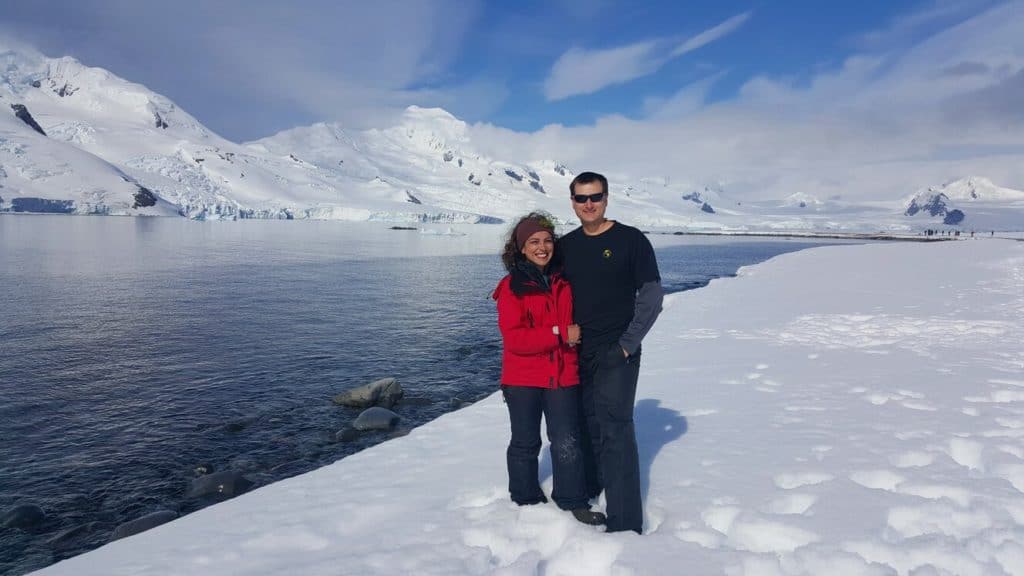
How to get to Antarctica
This post assumes you are visiting Antarctica as part of an organized Antarctica cruise from Ushuaia (or cruise/flight combo). There is really no other way to visit as a tourist, as Antarctic waters are heavily regulated and require permitted entry.
If you want to spend longer on the continent you can always try your luck at getting a job at one of the various research stations. Or you can always take your own yacht if you’re Zuckerburg rich.
Antarctic weather
Newsflash: it’s cold in Antarctica. Even in the summer, temperatures hover around freezing on the Antarctic Peninsula (the only part of Antarctica you’ll visit). The closer you get to the south pole the colder it gets.
But on a sunny summer day the temperatures can rise to well above freezing and it can be quite comfortable without a heavy jacket. It’s often cloudy in Antarctica but it doesn’t actually rain or snow very often. In fact, it’s one of the driest places on the planet.
Your biggest concern will be the wind. The wind can be downright brutal in Antarctica. And a really windy day means choppy seas that will prevent you from landing ashore.
Geography
The region of Antarctica that you will see is the Antarctic Peninsula and surrounding islands. It’s a sharp peninsula that juts north from the otherwise relatively prismatic island.
The peninsula and the islands are very mountainous and feature more areas free from ice than the rest of the island. The Antarctic Circle is near the top of the peninsula. Whether or not you make it to the circle will depend on your itinerary.
If you do the cruise to South Georgia Island, you almost certainly will not make it to the Circle. If you’re on the classic Antarctica cruise, you might make it there depending on the weather.

Penguin species in Antarctica
There aren’t as many species of penguins as you’d think in Antarctica. Six species can be found on the continent: emperor, adelie, gentoo, chinstrap, macaroni, and rockhopper. However, you almost certainly will not see emperor penguins – the largest species – as they don’t live at the northern tip of the peninsula.
Rockhoppers, macaronis and gentoos can only be found on the islands (we didn’t see any rockhoppers in Antarctica). Adelie and chinstrap are the most abundant penguins in the part of Antarctica you will visit.
Other Antarctic wildlife
There are plenty of other sea birds that you’ll see flying around as well as various types of seals. Refer to my post about preparing for the journey for a full discussion of Antarctic wildlife.
Four Days in Antarctica
Your Antarctica cruise from Ushuaia will most likely include four full days in Antarctica. The locations you will stop to go ashore vary depending on your expedition company and the weather. You’ll have between six and eight chances to land, depending on your itinerary.
I say “chances” because there is no guarantee you will be able to land. In order to come ashore you have to get into small inflatable rafts called zodiacs. The zodiacs carry about 8-10 people each and can land on the beach. There are no docks or cruise ports in Antarctica, so your cruise ship can’t really get close to the shore.
If it’s windy that means the water is choppy and it’s too dangerous to bring the zodiacs ashore. Rain won’t stop you from landing. Just the wind. Be prepared to miss out on a few landings due to the wind. Yes, it sucks. But it’s just the way it is.
Just one landing on the white continent will make it all worth it though. With four days of possibilities you’re bound to get some good weather. We had great weather all of our days in Antarctica, including a few sunny days that were so warm that I was walking around in a T-shirt!
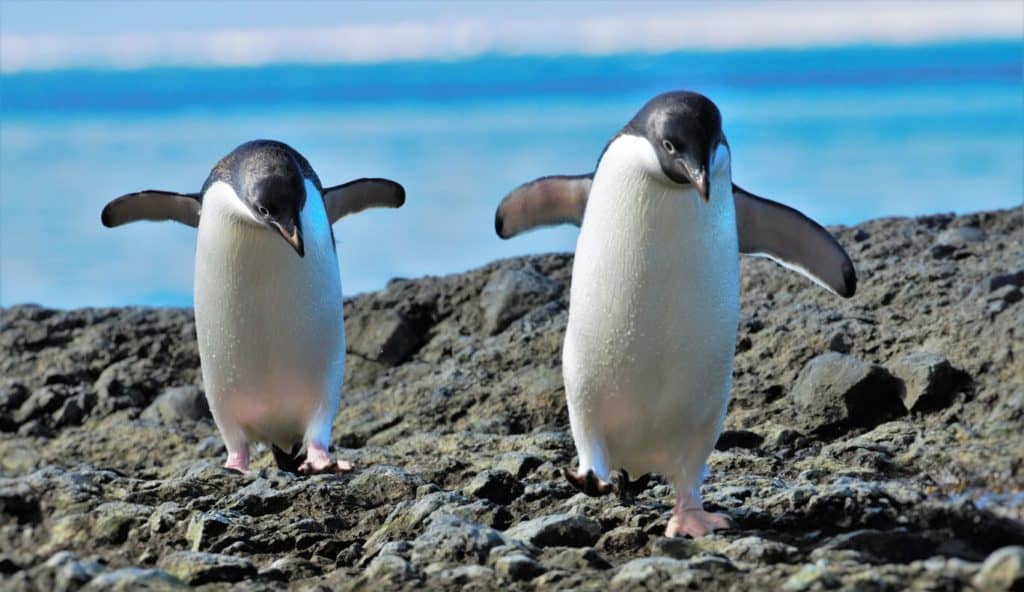
When we visited Antarctica it was part of a 19-day cruise that included the Falkland Islands and South Georgia Island. So we got a different experience than the “classic” Antarctica tour, which the majority of Antarctica visitors take.
The classic tour takes you to more locations on the Antarctic Peninsula than we got to see. But we got to hit a few of the islands that the classic tour does not make it to. The next sections go through the places we saw. If you are going on the classic tour, the locations will be different. But it will all be relatively similar. Penguins and mountains and ice, oh my!
The South Orkney Islands
The South Orkney Islands are a little over halfway between South Georgia Island and the tip of the Antarctic peninsula. It’s just barely south of 60 degrees latitude, so it’s one of the furthest north parts of Antarctica.
You will only see these islands if you’re on the longer cruise to South Georgia Island and the weather is good. Our guide told us that she hadn’t been able to stop in South Orkney in three years since the weather is usually so awful.
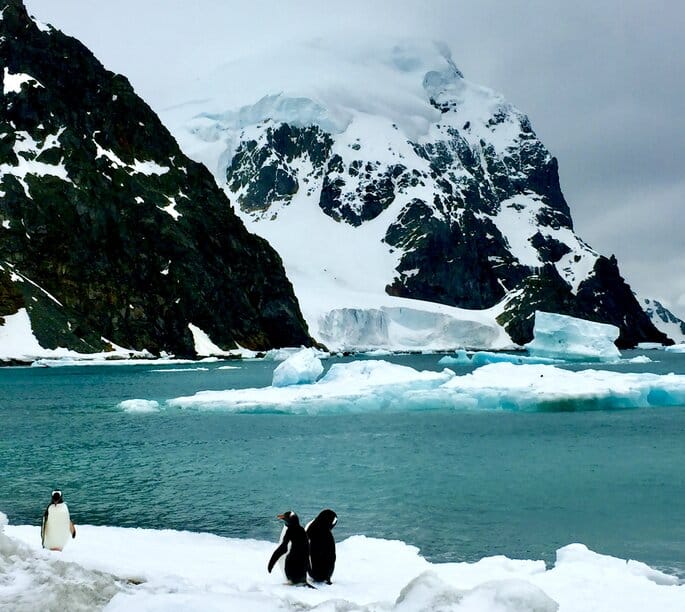
There is an Argentine research station on the islands that you will visit. Not a lot of cruises stop here so these guys will be excited to see you and tell you all about what they’re doing.
Other than that there isn’t much else to see, as the islands are so mountainous that you can’t really walk around unless you’re a professional rock climber. Here we saw our first chinstrap and adelie penguins, which are the most common species you will see in Antarctica.
I spent most of my time here just sitting on the rocks watching penguins waddle by as I took in the breathtaking Antarctic scenery. We didn’t spend long at South Orkney, as we had to get on the move to get to the Antarctic Peninsula the next day.
Brown Bluff
Brown Bluff is the very northern tip of the Antarctica Peninsula and is known for its colony of adelie penguins and it’s brown, rocky mountains. For us, getting off the zodiac here was a special occasion. After over two weeks on the cruise we finally set foot on Antarctica!
Technically, we had already been to Antarctica at South Orkney, but setting foot on the mainland was vital to the experience. Everyone cheered and high fived each other as we set foot on the White Continent.
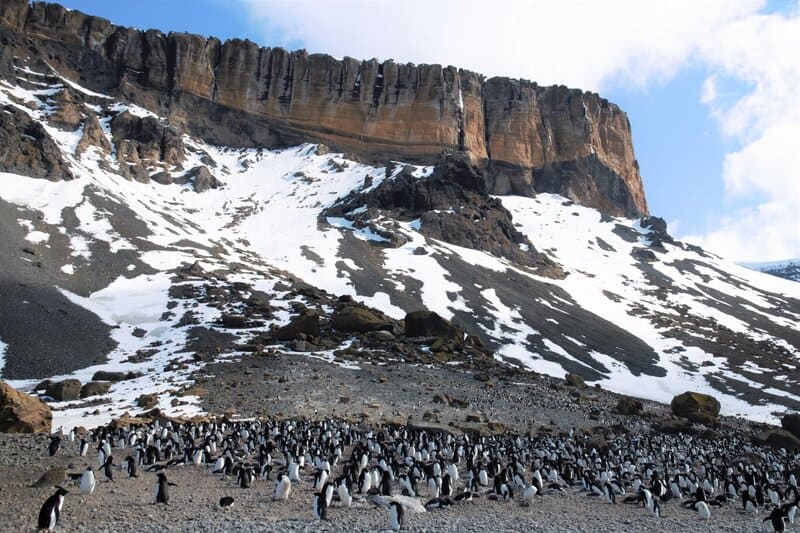
Brown Bluff is named after the reddish brown rocks that dot the coast. I was pretty fascinated by the geology of the coastline. Well, that was until I saw a giant colony of adelie penguins in the distance! There must have been a couple hundred thousand of them, all packed together family by family.
Penguins are monotonous and raise families like humans. There were tons of chicks in the colony. The fathers would go out to sea to hunt for fish while the mothers protected the babies.
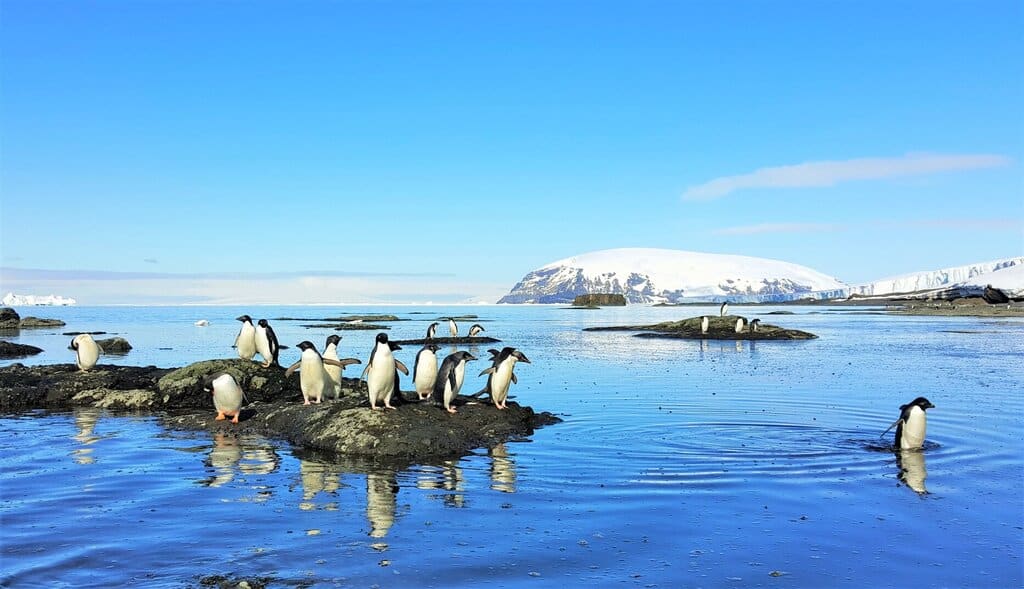
We had about three hours at Brown Bluff but it wasn’t enough. I was in awe just sitting on the rocks watching the penguins swim and run. The adelies are pretty hilarious.
Once I was sitting on a rock and one of them just jumped right out of the water to land on the rock next to me. He just stayed for a hot moment before hopping onto the shore. Brown Bluff was my favorite stop in Antarctica and I left with memories that will last me a lifetime.
Half Moon Island
Half Moon Island is part of the South Shetland Islands, northwest of the peninsula. We never actually set foot on the mainland again – just Brown Bluff – but the islands off the coast were arguably more spectacular and had better concentrations of penguins.
Half Moon Island is a rocky island with a high concentration of chinstrap penguins. This was the only place we saw chinstraps in high volume.

We had such a nice day at Half Moon Island that I decided to shed my jacket for a few minutes in favor of a T-shirt. That might sound crazy, but it was well above freezing that day and the sun was blazing. I was getting hot walking around in the jacket so I thought it would be a good idea to go sleeveless in Antarctica.
That idea lasted about a half hour before the wind picked up and I started freezing. But I will always be able to say I walked around Antarctica in a T-shirt!
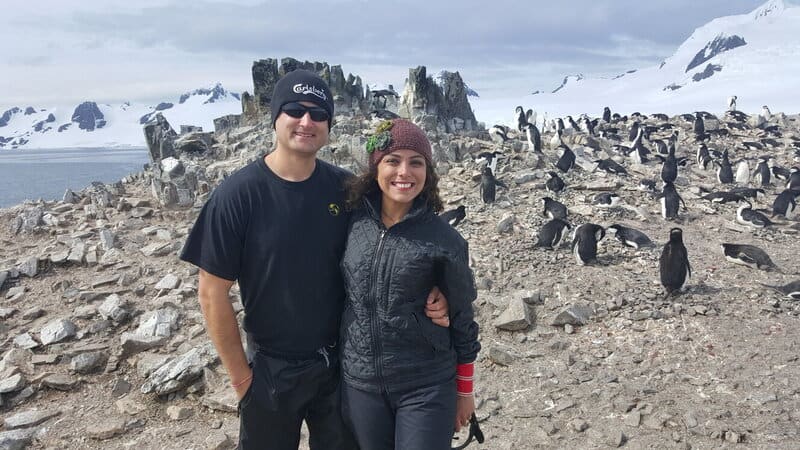
The island is large enough to wander around and observe penguins and seals on your own for quite some time. We had about three hours and felt that was a fair amount of time to get our fill.
Deception Island
The most visited spot in all of Antarctica is Deception Island. It’s the most popular spot because here you will be able to do the Polar Plunge, I.e. take a dip in the ocean.
You could theoretically do the Polar Plunge anywhere but this specific island is used for its unique geothermal activity. While the water in the sea is cold – barely above freezing – there is a geothermal beach where the water at the shore is actually warm. So you have the opportunity to sit in warm water after your dip in Antarctic waters.
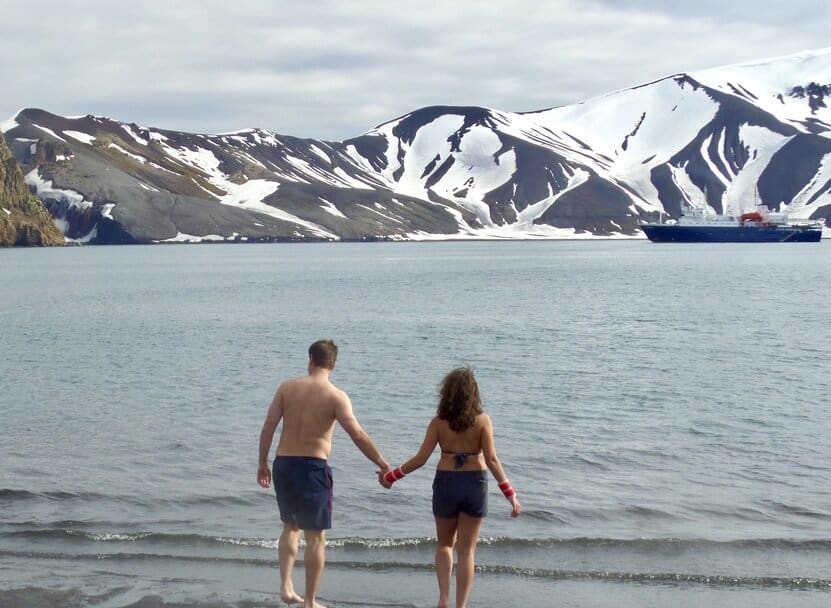
For me, the Polar Plunge lasted barely 10 seconds. There are no words that can describe just how cold that water felt. We were told it was about two degrees Celsius, by far the coldest water I’d ever felt in my life. It chills you to the bone.
The warm water at the beach was a life saver. I sat in it for a while to warm my core body temperature back up. We were also lucky that we had a relatively warm day and being outside in a swimsuit was not as painful as it could have been.
Not everyone on our cruise did the plunge. But I say go for it. You won’t get this experience again. After warming up you’ll have some time to explore the island, which is quite different due to the geothermal activity.
There are no penguin colonies on Deception Islands due to the geothermal activity, just a few stragglers walking around. There is also a short hike up a little mountain where you can get good views of the rocky coastline as well as a couple old shipwrecks on the shore.
Trinity Island
Our last stop in Antarctica was at Trinity Island. This island is very close to the mainland and you can see the peninsula on a clear day. Most people don’t get that opportunity but luckily we did. Here there is a limit that only 50 people can go ashore at a time. So we only got about an hour on land. It was super windy and cold, more like what I expected for Antarctica.
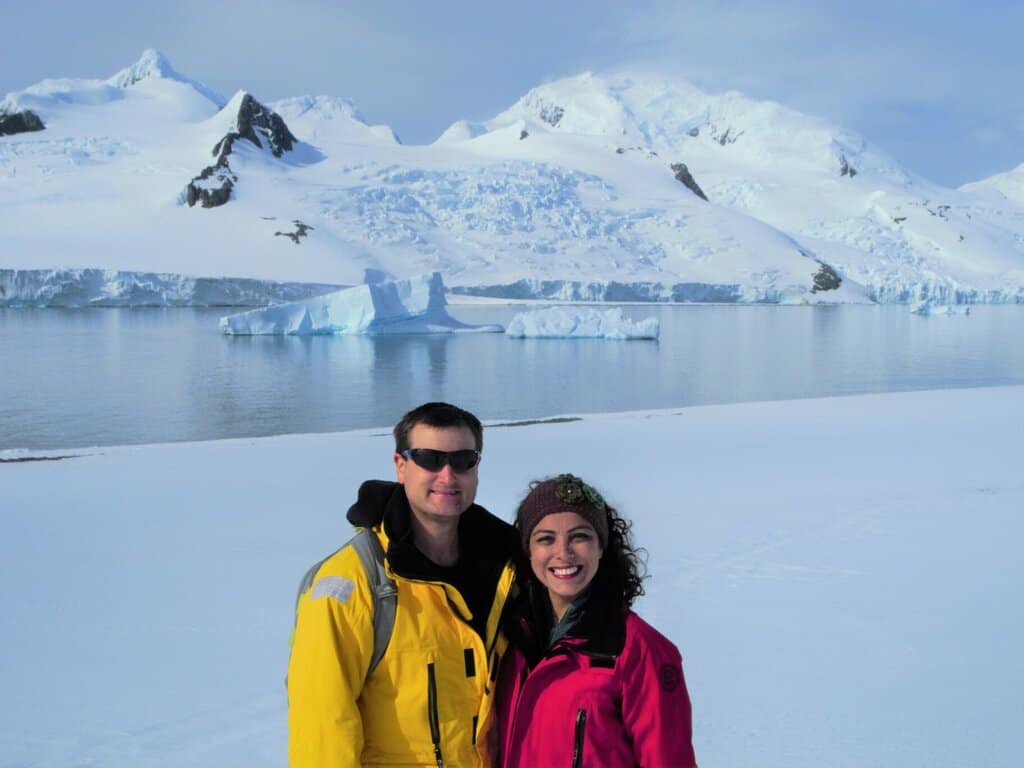
The island is very icy, but loaded with gentoo penguins. Of all the penguin species I think I found gentoos the most entertaining. I could have watched them waddle around all day.
After we left Trinity Island we cruised down the coast on the peninsula for a while, just taking in the sights and sounds. We didn’t quite make it to the Antarctic Circle but we had a special New Year’s Eve along the coast of Antarctica. The sky never got fully dark and we toasted to the new year as yellow light beamed across the horizon. Truly a NYE never to forget!

Antarctica – Frequently Asked Questions
How many people visit Antarctica each year?
The numbers grow every year, but as of the 2022-2023 travel season, over 32,000 people visited Antarctica. This does not include the 4000 or so people who reside at research bases on the continent.
Is it legal to visit Antarctica?
It is legal to visit Antarctica and many people do every year for tourism or research purposes. No passport is needed as it is not a country, but a protected natural environment owned by no sovereign nation. If you plan on visiting as part of a private expedition, however, you do need to obtain a permit.
Why is Antarctica guarded?
Antarctica is not really guarded by anyone, but it is a unique protected environment that is part of an international treaty. Anyone can visit Antarctica so long as you have the means and the money. If you’re not going as part of an organized cruise, however, you will need to obtain a permit and arrange your own ship.
How cold is Antarctica?
The temperatures in Antarctica are extreme. Thanks to it being a giant land mass, the South Pole is far colder than the North Pole. The average summer temperature at the South Pole is a balmy -18 degrees Fahrenheit (or -28 Celcius).
Where tourists visit is a different story though. It’s much warmer on the Antarctic Peninsula. Summer temperatures average just above freezing at 1-2 degrees Celsius. It’s possible for it to be much warmer or colder, however.
Why can’t you fly over Antarctica?
There is no law preventing any plane from flying over Antarctica. The reason that no planes fly over the continent is just that it’s not practical to. The vast majority of Earth’s landmass and population is in the northern Hemisphere. There’s no logistical flight route that goes over Antarctica.
Antarctica Cruise from Ushuaia – Final Word
A trip to Antarctica is the journey of a lifetime. It takes a fair amount of time and a solid financial commitment. But those who make the journey are rewarded with a trip unlike anything else this planet has to offer.
I guarantee you won’t be disappointed and won’t question why you paid so much once you get there. The pictures and memories from this trip are priceless. I’m sure you will love it as much as I do!


1 comment
[…] Expeditions is one of the most experienced and one of the best Antarctica cruises and cruise operators. Based out of the Netherlands, Oceanwide has an international staff of guides, captains, chefs, and […]